
In 2013, after the then-16+1 summit in Bucharest, Romania was bombarded with gushing headlines about a dozen Chinese investments and projects that would soon supercharge the Romanian economy, with the Cernavodă Nuclear Power Plant as the flagship project. Eight years later and nine governments apart, none of these projects were implemented, while disillusion with China accumulated.
Now, after a visit of a Romanian governmental delegation to the US, Romanian media are once again awash with the same gushing headlines. The only difference is that this time it is the “Americans” bringing billions, instead of the “Chinese”.
Everything started when the current US ambassador to Romania, Adrian Zuckerman, announced that Bucharest and Washington will sign an agreement for refurbishing a reactor and building two new reactors at Cenavodă as well as a a memorandum of understanding with the US EXIM Bank “for the financing of the Cernavodă nuclear project and other projects in Romania”. Zuckerman later brought up another American project: a highway and a railway connecting the Black Sea to the Baltic Sea, from Romania to Poland.
Soon after, Romanian media published an avalanche of articles announcing a “historic agreement” for “huge infrastructure projects” and “revolutionary investments”, as the “Americans have huge plans for Romania and Poland” and the “US will invest billions of dollars in Cernavodă”. The real picture is less rosy for Romania but remains informative as to how US-China competition is unfolding in third countries.
The Odyssey of the Cernavodă Nuclear Power Plant
Like other mammoth projects in the country, the five-unit Cernavodă Nuclear Power Plant was envisioned during the communist era. But because the construction of the first two reactors took more time than planned, becoming operational only in 1996 and 2007 respectively, Romania reconsidered the project. It was revived in 2009 with only four reactors, as units 3 and 4 were already partially built. This was the moment when reactors 3 and 4 began their incredible journey of finding financing, contractors and approvals.
First came the Europeans. In 2009 Nuclearlectrica, the state-owned company that operates Cernavodă, formed a joint venture with RWE (Germany), GDF Suez (Belgium), ENEL (Italy), CEZ (t Czech Republic), ArcelorMittal (Romania), and Iberdrola (Spain), but in less than three years all these companies withdrew from the project.
Then came the Chinese. After two years of discussions, in 2013 Romania signed a memorandum of understanding with China General Nuclear Power (CGN) at the then-16+1 summit in Bucharest. One year later, CGN won the tender as the sole bidder, leading to six years of negotiations complicated by political instability in Romania, ultimately leading to termination in early 2020.
Now come the Americans. In October 2020, Romanian and American officials signed an Intergovernmental Agreement that “will lay the foundation for Romania to utilize US expertise and technology with a multinational team building reactor Units 3 and 4 of the Cernavodă Nuclear Power Plant and refurbishing reactor Unit 1.” But what does this mean?
Building a nuclear power plant in an era when alternative energy sources are booming and becoming cheaper year by year is very risky. The value of the project was estimated at around $8 billion in 2013, a figure that has not been updated since. But, compared to other similar projects, the final cost might reach even double the original figure.
This investment was deemed unprofitable ten years ago when all the European companies withdrew from the project. It was deemed unprofitable over the past six years of negotiations with CGN, which insisted on government guaranties from Romania in the form of contacts for difference (Romania would guarantee a minimum price for energy and would pay the operator the difference if prices drop under that threshold over the lifetime of the reactors). And it will definitely remain risky and probably unprofitable ten years from now, when renewables will be even cheaper, while the investment time horizon for a nuclear power plant is around 30 years. Why would the US be interested in investing in a nuclear power plant in a faraway country, when a similar project at home failed, as was the case of Westinghouse at the Virgil C. Summer Power Plant project?
The Real US Involvement in Cernavodă
In fact, the whole story was a misconception due to the bombastic way it was presented in Romania, by both the US ambassador and the Romanian officials involved. The US did not say that it would invest in Cernavodă or that it would even finance such a project. The agreement the two countries signed was to provide Romania an access to American nuclear technology and expertise. Moreover, the $7 billion credit line with EXIM Bank will not finance Cernavodă specifically -which is estimated to cost $8 billion anyway, but is instead a “funding component for the development of energy projects — including nuclear and liquefied natural gas and infrastructure projects — road, rail, bunkering stations.” This is not a loan agreement, but Washington’s expression of interest in possibly financing different projects in Romania, providing they are built by American companies. Both the US ambassador and Romanian officials presented this as a done deal, but history advises us to be very careful about Cernavodă’s prospects and the difference between expression of interest and concrete implementation.
Initially, CGN was supposed to invest in Cernavodă, without any loan agreement by the Romanian side. But the negotiations for a contract for difference meant that the Romanian government would ultimately shoulder the risks and might end up paying CGN. This also raised issues about state aid, which the EU prohibits.
The financing agreement with the US raises a few issues. First of all, a loan is not as attractive as an investment, but, more importantly, in order for Romania to access the US EXIM bank loan in the first place, it must involve American companies. But EU rules call for a public tender for such a project, meaning that a different consortium might win. What is more, the EXIM financing proposal will not be enough to cover the full cost of Cernavodă, so other funds will have to be identified. Finally, it does not make much sense for Romania to take on a debt of billions of dollars to finance two nuclear reactors (or highways or railways, for that matter) when it can use EU funds to promote green energy projects.
Apart from this, the fundamental problem remains the economic rationale of the project. Fondul Proprietatea, a fund managed by the American financial firm Franklin Templeton Investments, which is a minority stakeholder in Nuclearelectrica, has consistently opposed the project of the two new reactors arguing that they are not profitable.
Ultimately, this project is not driven by market incentives or existing demand, but by government plans. While the investment could have worked ten years ago, it definitely will not work ten years from now, which is the estimated deadline for the completion of the project. Currently, US involvement in the refurbishing and modernization of reactor 1 is far more likely, as an American-Korean consortium has already expressed its interest for this project, estimated at $1 billion.
From Huawei to Cernavoda
The developments surrounding the Cernavodă project need to be seen in the wider context of regional rivalry between the US and China.
In August 2019, Romania started a trend in the CEE region, becoming the first country to sign an MoU with the US targeting Huawei’s participation in the 5G network, despite not mentioning it directly. Today, more than half of the members of the 17+1 mechanism have either signed such MoUs or joined Washington’s “Clean Network” initiative.
Romania was motivated by what I call “the Russian factor”, which made itself felt in some countries in the region, especially on the Eastern flank—the need for US security guarantees because of the fear of the threat posed by Russia. Based on this security interest, some regional governments were very open to take Washington’s side in its fight against Huawei.
But Romania went even further, deciding to end China’s involvement in its largest energy project. Unlike the fate of Huawei, which was a very public subject, with the US Embassy being vocal in criticizing the Chinese company, Cernavodă was never mentioned publicly. The battle instead took place in the background.
In September 2019, only five months after the Romanian government, then led by a left-wing party, signed an agreement with CGN to create the joint venture for the project, and one month after the Huawei MoU, Romania signed an MoU with the US on civil nuclear cooperation,.
In January 2020, the new right-wing prime-minister announced that Romania may give up on the Chinese involvement in Cernavodă. This decision materialized only in May 2020, when Romania publicly announced that it would end negotiations with CGN for building units 3 and 4. Yet according to the US ambassador, the US was already working on Cernavodă in December 2019,. while he pointed to March 2020 as the month when Romania terminated its agreement for Cernavodă with the Chinese company.
Political instability, unending negations with CGN for state guarantees to ensure profitability, disillusionment with Chinese investment promises, the “Russian factor,” the pro-US position of the new Romanian government, and the US lobbying all worked to transform Cernavodă from a Chinese project to an American one. While this is a geopolitical and PR victory for the US against China, the two new reactors at Cernavodă themselves are still nowhere near coming to life, nor are they on a path to profitability.
In Romania, the US scored multiple victories as it succeeded in convincing the Romanian government to sign an MoU on Huawei (whose provisions are now in the process of becoming law) and to replace a Chinese company in its biggest energy project. At the same time, Washington won popular sympathy by presenting all the as-of-yet-inconsequential MoUs as historic and revolutionary projects.
Finally, the US-Romania agreement also ends the saga of large-scale Chinese infrastructure investments in Romania, which began in 2013, but never became reality. Romania-China relations have deteriorated for years, a significant setback for Beijing, considering they were once close friends. Last but not least, Romania’s story also shows that fears of China’s influence all throughout the CEE region are out of touch with reality.
Written by
Andreea Brinza
AndreebrinAndreea Brînză is a Vice President of The Romanian Institute for the Study of the Asia-Pacific (RISAP). Her research focuses on the geopolitics and geoeconomics of China and especially on the Belt and Road Initiative.


